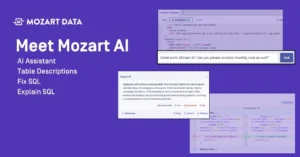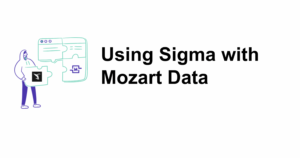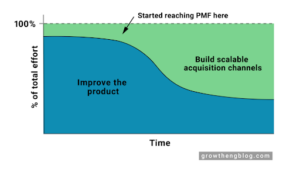The right data tooling helps users make the most of their siloed data. At any given moment companies are amassing data across a number of tools, like CRMs, social media and ad platforms, Google Analytics, and internal databases. Finding actionable insights to help drive the business becomes increasingly complicated — the longer you wait, the more painful and time-consuming the work will be.
We’re partnering with Mode because we believe it is an incredibly powerful tool made even more effective when paired with a modern data platform like Mozart.
What we love about Mode
Mode is a powerful business intelligence (BI) tool designed with a focus on ad-hoc analysis and self-service reporting, so both data teams and business teams are served with the same tool. For more technical or power users, Mode can work with the query languages the team prefers. However, the tool is also designed to quickly send data to business teams that are less likely to write complicated queries — without bottlenecks.
Mode’s BI platform includes a SQL query editor that enables users to easily perform ad-hoc analysis, answering important business questions as they come up. Those SQL query results can be directly loaded into R and Python libraries to rapidly move to even more advanced analytics, giving data analysts and data scientists all of the capabilities they could ask for.
These technical features don’t mean Mode is only suitable for the most technical of users. Mode’s built in data governance features make it simple to build reusable data sets and define key metrics, giving everyone on the team trustworthy data to work with. From there, Mode includes drag-and-drop visualization tools and interactive dashboards, so any user can dive into the data and look for the answers they need. The result is democratized data and the opportunity for a truly data-driven company culture.
What we love about automated data pipelines
Even technically robust BI tools like Mode begin to lose value when the data pushed into them is dirty or unreliable. Business intelligence tools aren’t designed to clean large data sets or combine data from multiple sources — especially over and over again.
Analysis and visualization of unreliable data isn’t useful. Missing out on insights that can only be discovered when combining multiple data sources can lead to a competitive disadvantage.
An automated data pipeline not only solves these problems, it makes data work less time-consuming and expensive. With a platform like Mozart’s, you can connect all of your various data sources to your own Snowflake data warehouse and schedule these sources to sync as often as you need them to. If you need to combine multiple data sources or clean them (which you likely will), you can schedule those data transformations to run — but only when the data is fresh, so you don’t waste resources.
The result is a reliable universal source of truth that a business intelligence tool, like Mode, can draw from. Users can perform more complicated analysis, quickly visualize insights, and build a self-serve data culture — without the need to hire data engineers to assemble their data pipeline.


